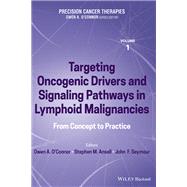A thorough compilation of the many scientific breakthroughs in the ongoing development of precision cancer therapies related to lymphoma
Targeting Oncogenic Drivers and Signaling Pathways in Lymphoid Malignancies: From Concept to Practice focuses on lymphoma, an area which has seen a remarkable number of breakthroughs in the ongoing development of precision cancer therapies. Each section on a specific biology or class of drugs has an introductory chapter written by an authority in the field, exclusively focused on the science and its relevance to cancer biology. This approach addresses the need for scientists, physicians, and the private sector to understand the broader context of the extraordinary advances that have produced such astonishing advances in the disease.
The work primarily focuses on how to understand and translate fundamental principles of basic science into information that can be directly applied to patients – hence the subtitle, From Concept to Practice. To aid in readers’ comprehension, the first page of each chapter contains a box entitled ‘Take Home Points’. This short text will highlight the major unique points about the information contained within the chapter. Some of the key topics addressed in the work are as follows:
- Biological basis of the lymphoid malignancies: fundamental principles of lymphomagenesis and molecular classification of lymphoid malignancies
- Targeting programmed cell death: principles for understanding the many types of cell death and promising combinations of drugs targeting apoptosis
- Targeting the PI3K pathway: understanding the intricacies of this complex biology and precisely how targeted drugs can be leveraged therapeutically
- Targeting the cancer epigenome: pharmacologic features of drugs targeting the epigenome and future prospects for targeting various aspects of epigenetic control
- Targeting the tumour proteome: understanding the mechanisms of protein degradation in cancer including both older drugs like proteasome inhibitors, and newer PROTAC based approaches
Written primarily for scientists and physicians in both the public and private sectors, Targeting Oncogenic Drivers and Signaling Pathways in Lymphoid Malignancies: From Concept to Practice is a comprehensive reference work for those interested in the growing area of Precision Cancer Therapies. Seamlessly integrating the basic and applied science, this volume will be an indispensable reference for those interested in translating the most important advances in science to innovative novel treatments for patients.








